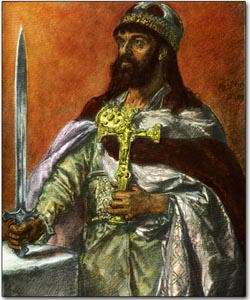Dilisme
| Dilisme | |
|---|---|
 Painting of Dilisme | |
| King of the Ragucin | |
| Reign | March 1297 – 17 June 1323 |
| Coronation | March 1297 at Kuldiga |
| Predecessor | Title created |
| Successor | Ivars I |
| Born | 1270 or 1271 Hytekia |
| Died | 17 June 1323 (aged 52–53) Ortwinlan, Ragucin Empire (present-day Königsreh, Mascylla) |
| Burial | |
| Spouse | Radegundis |
| Issue |
|
| House | House of Dilisme |
| Father | Ottmar (disputed) |
Dilisme (1270 or 1271 – 17 June 1323; aged 52 or 53) was a Ragaic-Hytek statesman, military commander, leader and soldier who ruled as King of the Ragucin from the Sack of Kuldiga by the Ragucin in 1297 to his death in 1323. The reign of Dilisme would oversee expansive conquest that would expand the Ragucin Empire's borders to include land in present-day Hytekia, Juznia, Anlaufhafen, Lilienburg, Mascylla, Tudonia, Kustlan, Dulebia, Brilliania and Alriika. His tactics in battle would revolutionise Erdaran, and more broadly global, combat and military formations, and brought cavalry combat to the forefront of military structure, using heavy swathes of Ragucin cavalry for his conquests.
Dilisme was born in 1270 or 1271 somewhere in Hytekia, believed to be somewhere near Lake Sigismund to an unknown figure named "Ottmar", although this is disputed by some historians. Little is known of his childhood but Dilisme grew quick and nimble on horseback and banded with a local Ragucin settlement to raid towns near Lake Sigismund. Outraged at the raids, the-then Duke of Houwerda, who ruled the lands of the Sigismund, imprisoned and executed Dilisme's unnamed brother. The execution led to the 1293 Sack of Kuldiga, where Dilisme and his followers sacked the Houwerdic capital in revenge, decisively defeating the Houwerdic army at the Battle of Kuldiga a day later, proclaiming the Ragucin Empire in its place.
Dilisme would embark on two decades of brutal conquest following the Sack of Kuldiga, conquering most of Erdara, bribing local administrators with money to keep order, but also retaining a high military presence in large cities where revolt was a risk. Dilisme never actually administrated the Empire himself, but acted moreso as a voice of reason and a final decision maker for the regional administrators of the Empire. Dilisme spent most of his time as King on the frontlines fighting, with many stories written during the reign of Dilisme detailing his heroisms and valour on the battlefield, and particularly his skill with a sword on horseback.
The Ragucin Empire would reach its largest extent in 1317 and retain the territory until 1332, when several revolts caused the Empire to abandon the poorly-administered borderlands of the Empire. Despite this, Dilisme governed the Empire well between 1317 and his death, and kept order using divide and conquer methods. Dilisme died in 1323 in Ortwinlan, now Königsreh, and his body was carried the entire journey between Königsreh and Krasno by servants of the new King, Ivars I; with the journey now being referred to as the March of Dilisme. He was the first ruler to be buried in Guzhe Chapel in Krasno, the resting place of Hytekojuznik monarchs, and is regarded as one of the most influential Erdaran rulers in history.